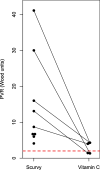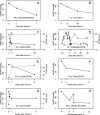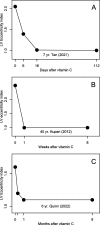Vitamin C deficiency can lead to pulmonary hypertension: a systematic review of case reports
- PMID: 38504249
- PMCID: PMC10949735
- DOI: 10.1186/s12890-024-02941-x
Vitamin C deficiency can lead to pulmonary hypertension: a systematic review of case reports
Abstract
Background: In the early literature, unintentional vitamin C deficiency in humans was associated with heart failure. Experimental vitamin C deficiency in guinea pigs caused enlargement of the heart. The purpose of this study was to collect and analyze case reports on vitamin C and pulmonary hypertension.
Methods: We searched Pubmed and Scopus for case studies in which vitamin C deficiency was considered to be the cause of pulmonary hypertension. We selected reports in which pulmonary hypertension was diagnosed by echocardiography or catheterization, for any age, sex, or dosage of vitamin C. We extracted quantitative data for our analysis. We used the mean pulmonary artery pressure (mPAP) as the outcome of primary interest.
Results: We identified 32 case reports, 21 of which were published in the last 5 years. Dyspnea was reported in 69%, edema in 53% and fatigue in 28% of the patients. Vitamin C plasma levels, measured in 27 cases, were undetectable in 24 and very low in 3 cases. Diet was poor in 30 cases and 17 cases had neuropsychiatric disorders. Right ventricular enlargement was reported in 24 cases. During periods of vitamin C deficiency, the median mPAP was 48 mmHg (range 29-77 mmHg; N = 28). After the start of vitamin C administration, the median mPAP was 20 mmHg (range 12-33 mmHg; N = 18). For the latter 18 cases, mPAP was 2.4-fold (median) higher during vitamin C deficiency. Pulmonary vascular resistance (PVR) during vitamin C deficiency was reported for 9 cases, ranging from 4.1 to 41 Wood units. PVR was 9-fold (median; N = 5) higher during vitamin C deficiency than during vitamin C administration. In 8 cases, there was direct evidence that the cases were pulmonary artery hypertension (PAH). Probably the majority of the remaining cases were also PAH.
Conclusions: The cases analyzed in our study indicate that pulmonary hypertension can be one explanation for the reported heart failure of scurvy patients in the early literature. It would seem sensible to measure plasma vitamin C levels of patients with PH and examine the effects of vitamin C administration.
Keywords: Antioxidants; Ascorbic acid; Case report; Heart failure; Oxidative stress; Pulmonary hypertension; Pulmonary vascular resistance; Scurvy; Systematic review.
© 2024. The Author(s).
Conflict of interest statement
H. Hemilä declares no potential conflicts of interest with respect to the research, authorship and/or publication of this article. A.M.E. de Man is coauthor of the LOVIT-COVID/REMAP-CAP trial [157] and received funding from the Netherlands Organisation for Health Research and Development for an RCT investigating high-dose vitamin C post-cardiac arrest, see doi: 10.1186/s13063-021-05483-3.
Figures




Similar articles
-
Reversible pulmonary hypertension associated with vitamin C deficiency.Chest. 2012 Jul;142(1):225-227. doi: 10.1378/chest.11-1857. Chest. 2012. PMID: 22796843
-
Reversible severe pulmonary hypertension related to scurvy in children.BMC Cardiovasc Disord. 2024 Jan 3;24(1):24. doi: 10.1186/s12872-023-03629-6. BMC Cardiovasc Disord. 2024. PMID: 38172747 Free PMC article.
-
[Pulmonary arterial hypertension as leading manifestation of methylmalonic aciduria: clinical characteristics and gene testing in 15 cases].Beijing Da Xue Xue Bao Yi Xue Ban. 2017 Oct 18;49(5):768-777. Beijing Da Xue Xue Bao Yi Xue Ban. 2017. PMID: 29045954 Chinese.
-
Revisiting Pulmonary Hypertension in the Era of Temporary Mechanical Circulatory Support - Literature Review and Case-Based Discussion.Transplant Proc. 2023 Dec;55(10):2462-2469. doi: 10.1016/j.transproceed.2023.09.022. Epub 2023 Nov 18. Transplant Proc. 2023. PMID: 37980253 Review.
-
Reversible right-sided heart failure and pulmonary hypertension caused by scurvy in a 7-year-old boy with autism spectrum disorder and a review of the literature.Paediatr Int Child Health. 2023 Nov;43(4):95-99. doi: 10.1080/20469047.2021.1901406. Epub 2021 May 25. Paediatr Int Child Health. 2023. PMID: 34033530 Review.
Cited by
-
Vitamin C Deficiency as a Readily Reversible Cause of Pulmonary Hypertension.JACC Case Rep. 2025 May 28;30(12):103424. doi: 10.1016/j.jaccas.2025.103424. Epub 2025 Mar 17. JACC Case Rep. 2025. PMID: 40447367 Free PMC article.
-
Forgotten Deficiency: A Case Series Highlighting Atypical Presentations of Scurvy in the 21st Century.Case Rep Med. 2025 Jun 23;2025:2118907. doi: 10.1155/carm/2118907. eCollection 2025. Case Rep Med. 2025. PMID: 40589921 Free PMC article.
-
Rebound effect explains the divergence in survival after 5 days in a controlled trial on vitamin C for COVID-19 patients.Front Med (Lausanne). 2024 May 21;11:1391346. doi: 10.3389/fmed.2024.1391346. eCollection 2024. Front Med (Lausanne). 2024. PMID: 38841576 Free PMC article. No abstract available.
-
Scurvy in a 65-year-old woman with severely limited function and social supports.CMAJ. 2024 Oct 6;196(33):E1144-E1146. doi: 10.1503/cmaj.240769. CMAJ. 2024. PMID: 39374969 Free PMC article. No abstract available.
-
Scorbut chez une femme de 65 ans dont la capacité fonctionnelle et le réseau social sont fort limités.CMAJ. 2024 Dec 1;196(41):E1377-E1379. doi: 10.1503/cmaj.240769-f. CMAJ. 2024. PMID: 39622538 Free PMC article. French. No abstract available.
References
-
- Lind J. A Treatise of the Scurvy in Three Parts. Edinburgh, UK, A. Kincaid and A. Donaldson. 1753. 10.1017/CBO9781107256644. https://archive.org/details/b30507054.
-
- Hemilä H. The symptoms of vitamin C deficiency. 1. Observations and descriptions by Hess, Lind, Trotter and Blane. Zenodo. 2024. 10.5281/zenodo.10685194.
-
- Hess AF. Scurvy: Past and Present. Philadelphia PA: Lippincott USA; 1920.
-
- Erdheim J. The heart in infantile scurvy [in German, translation available] Wien Klin Wochenschr. 1918;31(49):1293–5. doi: 10.5281/zenodo.7756493. - DOI
-
- Darling ST. The pathologic affinities of beriberi and scurvy. JAMA. 1914;63(15):1290–4. doi: 10.1001/jama.1914.02570150046011. - DOI
Publication types
MeSH terms
Substances
LinkOut - more resources
Full Text Sources
Medical
Research Materials

